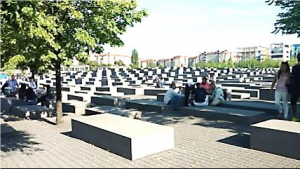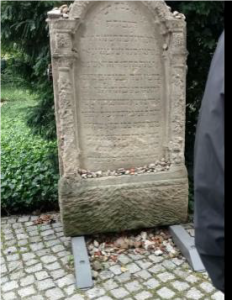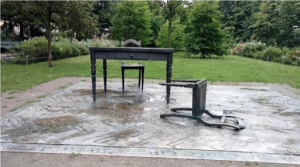By Amber Kalb
I traveled to Berlin, Germany in June 2017 for a Jewish studies program at Humboldt University. Memory of Berlin’s former Jewish inhabitants is omnipresent, inscribed into the buildings, on the cobblestones, and, of course, in the memorials that fill the public spaces as a reminder of those who were persecuted and perished in the Holocaust. I have been exposed to Germany’s ongoing memorial debates concerning the preservation of memory and how it ought to be done (whether through icons with specific lessons to imprint onto the public consciousness or by more ambiguous, conceptual monuments that resist passive speculation).
I was able to observe and, in some cases, speak with people in the “spaces of memory” or “the space between the memorial and the viewer” where one renegotiates the spatial and temporal boundaries that separate the lessons of the past from their applicability in the present (Young 2000: 374).
Over the course of eight weeks, I lived and learned under the same roof with a group of both Jewish and non-Jewish students (hailing from Toronto, Buenos Aires, Tel Aviv, Budapest, Madrid, Moscow, and the States, namely Florida, Kentucky and Texas), and the conversations often revolved around our experiences walking through a city that is a dizzying amalgam of sleek futuristic structures interrupted by surviving architectural relics of and memorials to Berlin’s past.
Of the various walking tours scheduled throughout the program, Berlin’s Jewish quarter was in many ways the most haunting. Armed with photographs from the interwar period, our tour guide would march us up and down gentrified streets pointing out the shops and apartments that had once been predominantly occupied by the Jewish communities. A kosher butcher on this corner, a record store on the next, all erased except for images he held up as proof of their transient existence. While much of Berlin’s Jewish communities has disappeared in the post-war period, the construction of memorials commemorating a murdered people has proliferated in public spaces all over Germany.
As the walking tours wore on, so would the number of memorials to which we were exposed. In speaking with fellow students, many expressed feeling suffocated by the sheer pervasiveness of them, while others walked seemingly unperturbed by their presence. One acquaintance would often avoid routes that were particularly crowded by monuments and memorials because of the intense feelings of melancholia they provoked. In another instance, at the Eisenman Memorial to the Murdered Jews of Europe, I watched as children jumped slab to slab as parents relaxed nearby enjoying what I imagined was an overdue family vacation.
As I reflected on the variety of ways each of us chose to engage with these spaces of memory, what stood out the most was a sense of disengagement. Perhaps, that is too simplistic of an interpretation of my limited observations and interactions, but I think there are some important questions contained in these moments of passive acceptance and avoidance.

Visitors resting on the concrete slabs of the Memorial to
the Murdered Jews of Europe. Photo by Amber Kalb.
What does it mean when memorials and monuments fail to engage people in memory work? How might we relate these relics of the past to the present? And, to what end?
Obviously, these questions have little to do with the monuments and memorials themselves (whether they be traditional, conceptual or otherwise), but rather what they symbolize to a society.
Ultimately, it is not the statues or icons that transmit lessons from the past into the present, but it is the continual conversations we have with one another and ourselves that create, maintain and eventually, renegotiate their meaning for the present.
During my stay, I would often find myself walking about the city, hoodie up, staring at my feet to avoid the spitting rain that seemed to find me whenever I ventured outdoors. My eyes were always naturally drawn to the gold Stolpersteine that perforated the brown and grey cobblestone.
Inscribed with the name and life dates of victims of Nazi extermination or persecution and placed in front of the homes where they were last known to freely reside, the Stolpersteine (meaning, “stumbling stone”) are one of the many civic commemorative efforts in Berlin and Europe designed to intrude on and interrupt the present with memories of the past.

The old Jewish Cemetery on Groβe Hamburger Straβe.
It was desecrated by the Nazis. Photo by Amber Kalb.
When I passed by a refugee center, overburdened and undersupplied, I wondered how people negotiate these new instances of persecution considering their memories of past Nazi crimes under the Third Reich.

A memorial in the former Jewish neighborhood of Berlin to its former residents who tried to escape deportation. Photo by Amber Kalb.
I wondered: Are daily errands interrupted by a sense of injustice as they enter these spaces of memory?
I realize this question seems rather historically and geographically limited, given transnational nature of contemporary Holocaust memory and the current political and social climate where monuments and their meanings are increasingly contested. But this question applies to every community that erects monuments in an effort to impart normative meaning and values to the next generation.
References
Young, James Edward. (2000). At memory’s edge: after-images of the Holocaust in contemporary art and architecture. New Haven: Yale University Press.
